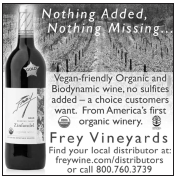The pace of retailing is breathless. You have a mile-long list of “to-dos,” and three feet of runway. You are not really in control of what happens today, or any day. Customers, order deadlines and deliveries drive the tempo, and employees who don’t show up and equipment that breaks down move the needle to prestissimo; like switching from Ravel’s Bolero to Rimsky-Korsakov’s Flight of the Bumblebee.
In this sort of environment, it’s challenging to make long-term progress on improving your store, or to do any planning beyond the moment. So, how can you bend the curve of your business more toward your vision? By taking small bites.
If you are like most naturals retailers, you wind up dealing largely with the things that are critical. Critical items are those that, if you don’t address them, would bring your business to a halt. This includes ordering product, replacing the cash register tape and fixing the freezer. While you must deal with the critical things that occur daily, that still leaves a whole swath of important things you would like to achieve in your business, but that you just can’t seem to get time to address.
Critical, Important or Just Nice to Have?
While it’s easy to tell what’s critical in your store—you’re out of business if you don’t fix this RIGHT NOW—it’s much harder to distinguish between things that are important and those that are simply nice to have. Things that are nice to have might make you or your employees happy for a while, but those that are truly important will have a more meaningful, long-lasting impact on your customers and your business.
For example, it would be nice to get that new wide-screen computer  monitor your buyer may be asking for, or redoing your Web site to be more tailored to your store, or setting up streaming Internet music to your employee break room. All of these perks would be nice to have, but their impact on your customers will be slight, at best.
monitor your buyer may be asking for, or redoing your Web site to be more tailored to your store, or setting up streaming Internet music to your employee break room. All of these perks would be nice to have, but their impact on your customers will be slight, at best.
Things that are important, on the other hand, are those that will have a more direct impact on your customers, like a new paint job on the walls, new shelving, lighting, flooring or ceiling treatment.
So, how do you decide which things are important and which are just nice to have? Start by listing all the things you’d like to accomplish in your store, both long and short term. Once you have your list, ask this question of each item: How will this change improve my customers’ shopping experience?
Answering this question should create two lists: those items that are important, and those that are merely nice to have. Put aside the nice-to-haves for now and focus on the important.
Moving Ahead
Since I am not sitting with you, the best I can do is try to imagine some of the items you believe are important. Based on my personal observation of independent retailers around the country over the years, here are some of the areas that may benefit from your attention.
 Back room. OK, you say, how will making changes to my back room improve my customers’ shopping experience? If your back room is cluttered, disorganized and you can’t efficiently receive orders or keep track of back stock, then improving these things will speed receiving and reduce out-of-stocks and overstocks. Plus, your employees will feel better when they have to handle work in the back room, and will look better in the eyes of your customers when they can quickly locate the item that’s out of stock on the shelf in your retail area.
Back room. OK, you say, how will making changes to my back room improve my customers’ shopping experience? If your back room is cluttered, disorganized and you can’t efficiently receive orders or keep track of back stock, then improving these things will speed receiving and reduce out-of-stocks and overstocks. Plus, your employees will feel better when they have to handle work in the back room, and will look better in the eyes of your customers when they can quickly locate the item that’s out of stock on the shelf in your retail area.
Are pallets leaning on end against the wall of your back room? This is an OSHA (Occupational Safety and Health Administration) violation, not to mention an unsafe working condition. Focusing on the efficiency and safety of your receiving and preparation areas in your back room is time and money well spent.
Is your employee bathroom doubling as a mop closet? Some investment here to create a cleanable, sanitized environment will go a long way toward improving employee morale, which directly impacts customer service levels. When you show respect for your employees by making their jobs easier and safer—even though these changes may be hidden from the customer—your customers will benefit from the effects of a happier, more efficient workforce.
Retail area. When was the last time you had a professional cleaning service address your retail floor? Whether you have a hard surface or carpet, regular cleaning is probably the single most important thing you can do to improve your customers’ shopping experience. Because you look at it every day, you may not notice the accumulated grit around your checkout counters and wedged in at the base of your shelving kick panels. Perhaps even some of your regular shoppers have stopped paying attention to this. But once you address it, shoppers will notice the improvement and will likely reward your efforts with the increased intention to shop with you.
A great project for your team’s closing or  opening routine is to damp-wipe the shelves. In the spirit of small steps, staff can tackle the task one shelving bay—your two-foot, three-foot, or four-foot shelving sections—at a time per day. This means only a small amount of inventory is displaced at any moment, and the store can quickly be ready for business.
opening routine is to damp-wipe the shelves. In the spirit of small steps, staff can tackle the task one shelving bay—your two-foot, three-foot, or four-foot shelving sections—at a time per day. This means only a small amount of inventory is displaced at any moment, and the store can quickly be ready for business.
As an added bonus, staff can count the inventory on that section of shelving as they replace it on the cleaned shelf, giving you fresh numbers for your inventory on hand. Counting inventory in series like this, a section at a time instead of all at once, is called a “cycle count.” Eventually, probably by the time a calendar quarter has elapsed, you’ll have cleaned and counted your whole store. Doing these two tasks—cleaning and counting—rotating a section at a time throughout your entire store will raise and maintain a higher level of store cleanliness and give you a more accurate inventory figure that will improve buying and reduce out-of-stocks.
Inventory. Let’s talk a bit more about your inventory. Because inventory is your biggest investment after your equipment and fixtures, zeroing in on some basic controls can improve your results and your customers’ shopping experience.
As you know, a small percentage, typically 20–30% of your products, accounts for 70–80% of your sales. Identifying these products, and then setting minimum and maximum stock levels for them, can reduce your out-of-stocks and help maintain consistent inventory-to-sales ratios, or inventory turns.
If you have a point-of-sale system, you can automatically run the reports that show your product movement and which items fall into your top sales echelon. By the way, if you don’t have a point-of-sale system, you’ll have to rely on dated shelf tags that indicate your last order date for that item to determine product movement.
Either way, you’ll be able to see where the break is, where your product movement goes from a higher level to a lower level. Drawing the line at that point—whether it is 20, 25 or 30% of your items—will allow you to focus on the correct inventory level for this top group.
 Depending on your order cycle for each item (e.g., daily, weekly or less frequently), set your minimum stock level at 1.25 to 2.0 times your average movement between order cycles. This will help ensure you never run out of stock on these items. Since you may be bumping up inventory on some of these items, you may need to increase shelf facings to accommodate the higher on-hand counts. This is actually beneficial to sales because the increased facings will be a bolder, more prominent visual statement that shoppers will recognize more quickly and easily. This creates a virtuous circle; since your better sellers appeal to more of your customers, and more of your customers will see your top sellers, movement on these items will accelerate.
Depending on your order cycle for each item (e.g., daily, weekly or less frequently), set your minimum stock level at 1.25 to 2.0 times your average movement between order cycles. This will help ensure you never run out of stock on these items. Since you may be bumping up inventory on some of these items, you may need to increase shelf facings to accommodate the higher on-hand counts. This is actually beneficial to sales because the increased facings will be a bolder, more prominent visual statement that shoppers will recognize more quickly and easily. This creates a virtuous circle; since your better sellers appeal to more of your customers, and more of your customers will see your top sellers, movement on these items will accelerate.
What to do with the other items not in your top-selling group? The first thing you’ll have to do is reduce facings on those items to make room for the expanded space your top sellers need. Next, start at the bottom of that movement report you printed out and begin reviewing with your team why each of those slow movers deserves a place on your shelves.
Unless your team can explain, in 10 words or less, why this product is unique, better or necessary, then it is a candidate for discontinuing. Be skeptical of the argument that Mrs. Smith loves this product, and every six months when she comes in, she expects it to be there. Your real estate is far too expensive to justify allowing that slow mover to remain on your shelves. Ask your team to explain to Mrs. Smith that your concern is that she enjoys the freshest product possible, and that you’ll happily special order it for her, with a deposit, of course. If it’s a case item, perhaps Mrs. Smith would like to take the entire case for a significant discount.
Strategy. In addition to these nuts-and-bolts improvements you can make to your store, consider setting aside a bit of think-time to plan your competitive strategy. Although strategy is often invisible, it is no less important than the tangible items on your to-do list.
Strategy is the art of understanding what makes you better than, and different from, your competitors, and then highlighting those differences in all that you do. Maybe it’s your nutritional expertise, or your willingness to engage each customer individually in his or her health concern. Perhaps it is your focus on unique local or fresh items. Or, maybe it is the comfortable, easy-to-shop environment of your retail space that saves time and reduces the stress compared to shopping elsewhere.
Whatever your competitive differences are, refreshing them, highlighting them and reminding your team, your customers and your community of the unique advantages of shopping with you is actually more important than important; it’s critical.  Good luck! WF
Good luck! WF
Jay Jacobowitz is president and founder of Retail Insights®, a professional consulting service for natural products retailers established in 1998, and creator of Natural Insights for Well Being®, a comprehensive marketing service designed especially for independent natural products retailers. With 36 years of wholesale and retail industry experience, Jay has assisted in developing over 1,000 successful natural products retail stores in the U.S. and abroad. Jay is a popular author, educator, and speaker, and is the merchandising editor of WholeFoods Magazine, for which he writes Merchandising Insights and Tip of the Month. Jay also serves the Natural Products Association in several capacities. Jay will be exhibiting at National Products Expo East in Baltimore, MD, September 26—28, at booth #6030. He can be reached at (800)328-0855 or via e-mail at jay@retailinsights.com.
Published in WholeFoods Magazine, September 2013










